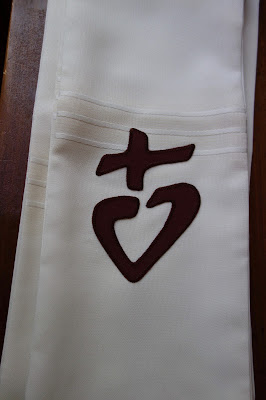“I want to be buried in Easter time,” a priest friend
recently told me after a funeral Mass.
I don’t know how many funeral Masses he has had in these
past three weeks of Easter, but I assisted him in three funeral Masses and
presided at two other funeral Liturgies of the Word with Communion.
Since being ordained a deacon, I have been present at more
funerals. Sometimes, as was the case of three of those we buried, I had brought
them communion – or being with the pastor when he anointed them and brought
them communion.
Visiting the sick and burying the dead might seem to be dark
and depressing, but, for me, they have been redemptive. It is a way to accompany people, trying to open up for people the presence of a God made flesh who died for and with us and who is risen.
How appropriate to celebrate dying and death - in the season when we celebrate the risen Jesus, who still bears the wounds of his death.
I was particularly moved about ten days ago when I brought
communion to two people dying of cancer.
One was a young woman with three young children. She was
alert and peaceful. When I gave her communion, her oldest daughter was present.
I asked her if she had yet received her first communion. She hadn’t but was
preparing. The next time I saw her, she was beside her father, younger sister,
and younger brother, at the side of the coffin of her mother in church.
The other was Don Efraín, here in Plan Grande. I wrote about
him a few days ago log post here. in a b. His peacefulness and acceptance of death moves me. We
buried him yesterday near the top of the hill of the cemetery in Candelaria,
the next town over.
But there was another funeral that moved me – a poor indigenous
woman, 28 years old, María Confesora. I had been present when Padre German
anointed her and gave her communion one night in December. She lived in a
small, rented house with her parents and a brother, in Dulce Nombre. I was
moved when one of the stations of the cross of our parish’s Via Crucis stopped
outside their house. Padre German went in and prayed with her during the
station and, through the magic of remote microphones, we heard her pray with
us.
The funeral was held early Monday morning in Dulce Nombre.
But the family wanted to bury her in their home town of La Jigua. They had no
money to pay for transporting the coffin, which had been given them. So I ended
up transporting the coffin in my pick up – in a 90 minute or so trip from Dulce
Nombre.
When we arrived in La Jigua, they wanted to go to the
church. They got someone to open the church and brought the coffin in. Before a
short service, I spoke with a woman who was cleaning the church. She knew the
family and told how María Confesora was involved in the church, willing to help
out in cleaning the church and whatever else might be needed. It’s amazing what
we don’t know about people. I had only known her as a bed-ridden suffering
young woman. But she had been an active participant in the life of her hometown
faith community.
We brought the coffin to the cemetery where we finally
interred her body. I brought some of the family back to Dulce Nombre.
Yesterday, we buried Don Efraín. The church in Plan Grande could
not contain all the people who came. Afterwards, I went to the cemetery to pray
at the graveside.
Priests (or a deacon) don’t often go to the graveside,
partly because of the distance and time involved. The family often walks with
the casket from the church to the grave. That can be an hour or more.
But I went and prayed and spoke with the widow, a brave woman, with the sisters of Efraín who had come from their homes in El Salvador, with
some of their eleven children, and with a number of the grandchildren. My
impression of Don Efraín as a gentle, humble, and loving person was reinforced by their testimony.
The tradition here in Honduras is that the people wait in
the cemetery until the tomb is sealed. If the body is buried in a concrete
vault in the ground, they pour cement over boards placed over the vault.
I was deeply moved, and concerned, about one of the sons who
wept openly over the coffin and, at the last moment, opened the top of the
casket to get a glimpse of his father. I don’t know the story, but he was
really distressed. After the burial I went and embraced him. He thanked me for all
I had done – which I consider all too little.
Last night, reflecting on this encounter and on the many
occasions when I have given hugs to family members who ended up crying on my
shoulders, I realized something. It is not me, but the presence of the Church,
the people of God, that gives me the strength to be there to embrace those who
are in mourning and, perhaps, offer a word of consolation and encouragement.
The servant, the deacon, is called to be there, to accompany
people in their daily lives, their joys and their sorrows. It is a great
privilege – and a ministry that can give deep joy.























